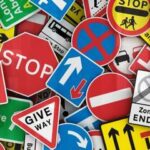News & Events
Road Signs and What they Mean
Below are some of the most important and widely spread road signs:
Yield Sign
Yield signs are red and white, and the letters inscribed on them are red. They alert drivers of oncoming traffic or hazards along the way. They are usually placed before intersections. Upon seeing a yield sign or its equivalent, which is a flashing yellow light, drivers must slow down, stop to give way, proceed when the road is clear and remain aware of their surroundings.
Stop Sign
Stop signs are red with white letters. Upon seeing a stop sign, drivers must make a full stop and give way for other vehicles or pedestrians crossing in front of them and proceed only when the road is clear. They are usually placed before intersections. The equivalent of a stop sign is a flashing red light.
Traffic Lights: Red, Orange and Green
Traffic lights are among the most serious traffic signals. Drivers are obliged to stop and yield the right of way for other vehicles when the red light flashes. The orange light means that drivers should slow down before crossing an intersection and yield in order to prevent any incident during the switch between the red and green lights. The green light means that drivers can proceed, but they are still asked to look both ways before crossing an intersection: another driver might jump their red light, for example, or an emergency vehicle could be crossing the intersection in a hurry. Moreover, the law requires drivers to yield to the traffic already in the intersection even if the light turned green.
Additional Signs
Circular arrows have the same meaning as traffic lights, depending on their colors. The lines on roadways serve two purposes, depending on their colors as well: yellow lines separate traffic travelling in opposite directions, and white lines separate traffic travelling in the same direction. Guide signs exists in a wide range of shapes and colors, and they inform drivers about what road they are on, in which direction they are headed, etc. Traffic regulatory signs are also very distinct: they either prohibit acts in a visual form, direct traffic in certain directions, set speed limits, etc.

